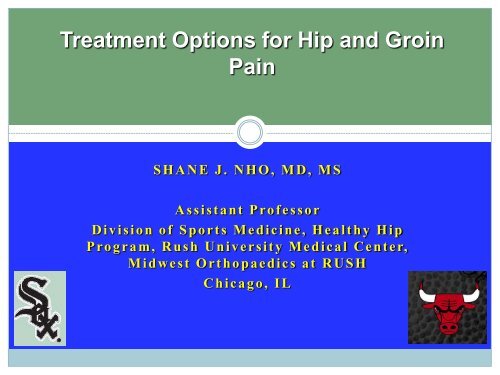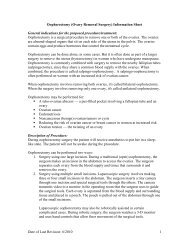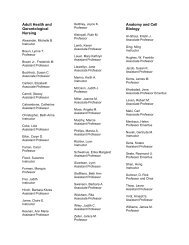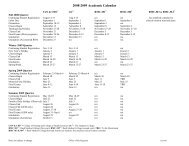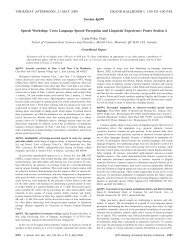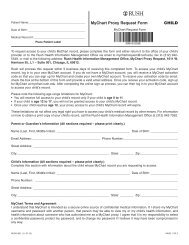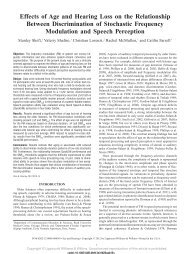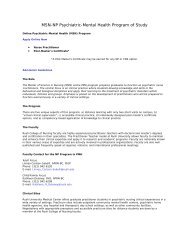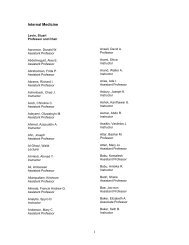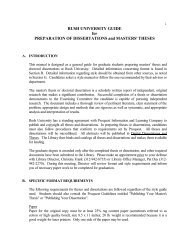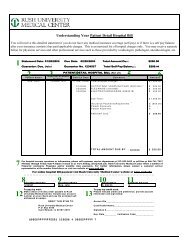Treatment Options for Hip Pain - Rush University Medical Center
Treatment Options for Hip Pain - Rush University Medical Center
Treatment Options for Hip Pain - Rush University Medical Center
You also want an ePaper? Increase the reach of your titles
YUMPU automatically turns print PDFs into web optimized ePapers that Google loves.
<strong>Treatment</strong> <strong>Options</strong> <strong>for</strong> <strong>Hip</strong> and Groin<br />
<strong>Pain</strong><br />
S HANE J . N HO, M D , M S<br />
A ssistant Pro f essor<br />
D ivision o f S p o rts M edicine, Healthy <strong>Hip</strong><br />
Pro g ram, R ush U niversity M edical C enter,<br />
M idwest Orthopaedics a t R U S H<br />
C h icago, IL
A B O U T M E :<br />
B O R N I N C H I C A G O S U B U R B S<br />
N O R T H W E S T E R N U N I V E R S I T Y ‘ 9 8<br />
R U S H U N I V E R S I T Y<br />
Introduction<br />
M D , R U S H M E D I C A L C O L L E G E ‘ 0 3<br />
M S , T H E G R A D U A T E C O L L E G E ’ 0 3<br />
O R T H O P E D I C S U R G I C A L R E S I D E N C Y ,<br />
H O S P I T A L F O R S P E C I A L S U R G E R Y ’ 0 8
Introduction<br />
F E L L O W S H I P , S P O R T S M E D I C I N E , R U S H<br />
nho54456<br />
U N I V E R S I T Y M E D I C A L C E N T E R<br />
• Healthy <strong>Hip</strong> Program: Charles A. Bush-Joseph, MD;<br />
Walter A. Virkus, MD; Jorge O. Galante, MD<br />
H E R O D I C U S T R A V E L L I N G F E L L O W S H I P<br />
I N H I P A R T H R O S C O P Y & H I P J O I N T<br />
P R E S E R V A T I O N<br />
• Michael Leunig, MD @ Schulthess Klinik, Zurich,<br />
Switzerland<br />
• Marc J. Philippon, MD @ Steadman Hawkins Clinic,<br />
Vail, Colorado<br />
• J.W. Thomas Byrd, MD @ Nashville Sports Medicine<br />
and Orthopaedic <strong>Center</strong>, Nashville, Tennessee<br />
• Bryan T. Kelly, MD @ Hospital <strong>for</strong> Special Surgery
Pic of Sisters<br />
QuickTime and a<br />
TIFF (Uncompressed) decompressor<br />
are needed to see this picture.
<strong>Hip</strong> in the News<br />
A-Rod<br />
2008 2009
Fig. 1 The projected number of primary total hip arthroplasty (THA) and total knee<br />
arthroplasty (TKA) procedures in the United States from 2005 to 2030.<br />
Kurtz S. et.al. J Bone Joint Surg 2007:89:780-785<br />
174% Growth in Demand <strong>for</strong> THA
� Why Now?<br />
� Combination of several<br />
factors<br />
� Media coverage<br />
� Success of the Total <strong>Hip</strong><br />
Replacement<br />
� <strong>Hip</strong> arthroscopy has been<br />
per<strong>for</strong>med since 1990s �<br />
technique evolved<br />
� Improved understanding of<br />
hip pathology<br />
� Femoro-Acetabular<br />
Impingement<br />
<strong>Hip</strong> in the News
What Is <strong>Hip</strong> <strong>Pain</strong>?
Causes of <strong>Hip</strong><br />
or Groin <strong>Pain</strong><br />
Burnett, Clohisy<br />
et al. JBJS 2006<br />
•Average time<br />
from injury to<br />
accurate<br />
diagnosis 21<br />
months<br />
•Average of 3.3<br />
providers seen<br />
be<strong>for</strong>e definitive<br />
treatment<br />
� Anterior <strong>Hip</strong> <strong>Pain</strong><br />
� Muscle strains<br />
� Contusion (hip pointer)<br />
� Avulsions and apophyseal injuries<br />
� <strong>Hip</strong> dislocation/subluxation<br />
� Acetabular labral tears and loose bodies<br />
� Proximal femur fractures<br />
� Osteitis pubis<br />
� Iliopsoas bursitis<br />
� Stress syndrome<br />
� SCFE<br />
� Perthes disease<br />
� Developmental dysplasia<br />
� Osteoarthritis<br />
� Inflammatory Arthritis<br />
� Avascular Necrosis<br />
� Femoro-acetabular Impingement<br />
� Lateral <strong>Hip</strong> <strong>Pain</strong>:<br />
� Greater trochanteric bursisits<br />
� Gluteus medius/minimus tear<br />
� ITB syndrome<br />
� Meralgia paresthetica<br />
� Posterior <strong>Hip</strong> <strong>Pain</strong><br />
� Lumbar spine abnormalities<br />
� Compression neuropathies<br />
� Piri<strong>for</strong>mis syndrome<br />
� SI joint pathology<br />
� Other Causes of <strong>Hip</strong> <strong>Pain</strong>:<br />
� Abdominal (sports hernias and athletic pubalgia, inguinal hernias,<br />
appendicitis)<br />
� Gynecologic (ovarian cysts, PID, pregnancy)<br />
� Urologic (testicular, scrotal)<br />
� Genitourinary (kidney stone, nephritis)
Other Possible Causes of <strong>Hip</strong> <strong>Pain</strong><br />
� 5 main sources:<br />
� GI<br />
� GU<br />
� Athletic pubalgia, inguinal<br />
hernias, appendicitis<br />
� Kidney stone, nephritis<br />
� Gyn<br />
� Ovarian cysts, PID, pregnancy<br />
� Neurological<br />
� Musculoskeletal<br />
� Psychological
� Acute<br />
� Sudden onset, sharp rise, and<br />
short course<br />
� Often assoc with autonomic<br />
response (n/v, diaphoresis, etc) or<br />
signs of inflammation (f/c,<br />
leukocytosis)<br />
� Chronic:<br />
� >6 mos duration<br />
� Causes functional disability<br />
or necessitates treatment<br />
� 10-20% of women in US are<br />
affected<br />
� ~10% of all gyn visits due to this<br />
� 12-19% of hysterectomies<br />
per<strong>for</strong>med <strong>for</strong> chronic pelvic pain<br />
� Cyclic<br />
� Associated with menstrual cycle<br />
<strong>Hip</strong> vs. Pelvic <strong>Pain</strong><br />
� <strong>Pain</strong><br />
� <strong>Pain</strong> / ache in vagina or<br />
rectum<br />
� Pressure sensation<br />
� Abdominal tenderness<br />
� Rebound or guarding<br />
� Associated symptoms:<br />
related to menses,<br />
intercourse, urine,<br />
incontinence<br />
� Cramping<br />
� Bloating
� Do I have hip pain?<br />
� <strong>Hip</strong> pain characteristics<br />
� „C‟ sign<br />
� Groin<br />
� Worse with start-up activities,<br />
prolonged sitting (chair or car),<br />
prolonged activity or sports, uphill,<br />
putting on shoes/socks, getting in and<br />
out of car<br />
� Can be ATYPICAL!<br />
� Mechanism<br />
� Acute event: fall or trauma<br />
� Insidious<br />
� Associated symptoms<br />
� Mechanical symptoms : catching or<br />
locking<br />
� Snapping<br />
� Instability<br />
� Stiffness<br />
Patient Presentation
� Gait<br />
� Active / Passive ROM &<br />
strength of both hips<br />
� Limited IR<br />
� Hypermobile<br />
� Lateral pain with<br />
palpation<br />
� Abductor weakness<br />
� Impingement sign: pain<br />
with flexion/internal<br />
rotation<br />
� FABER test<br />
� Evaluation <strong>for</strong> athletic<br />
pubalgia<br />
Physical Exam
Imaging Studies<br />
Radiographic Appearance of <strong>Hip</strong>s<br />
Impingement (Deep)NormalDysplasia (Shallow)
Who Gets <strong>Hip</strong> <strong>Pain</strong> & Why?<br />
� Abnormal anatomy:<br />
“normal” use<br />
� Normal anatomy:<br />
abnormal use exceeds<br />
tolerance of joint<br />
structures<br />
� Acute injury<br />
� Chronic abuse/overuse<br />
(occupational,<br />
recreational)<br />
• Combination: abnormal<br />
anatomy and abnormal<br />
use
1. NSAID<br />
� Oral<br />
Non-Surgical <strong>Treatment</strong><br />
<strong>Options</strong><br />
� Local delivery: Voltaren gel or Flector patches<br />
2. GLUCOSAMINE &<br />
CHONDROITIN<br />
3. PHYSICAL THERAPY<br />
� Active Release Therapy<br />
4. INJECTIONS<br />
� Intra-articular<br />
� Selective
Glucosamine & Chondroitin
Corticosteroid Injections<br />
26 RCT Cortisone vs Placebo<br />
Cortisone <strong>for</strong> pain at 2 weeks<br />
No difference at 4 weeks (Bellamy 2006)
� Intra-articular Injection<br />
� Positive Test<br />
� 90% accuracy of<br />
determining intraarticular<br />
etiology of hip<br />
pain<br />
� Patients with intraarticular<br />
pathology have<br />
improved outcomes with<br />
arthroscopy<br />
� Selective Injections<br />
� Trochanteric, SI joint,<br />
Spine<br />
Byrd & Jones. AJSM 2004.<br />
Injections
Physical Therapy / Active Release Therapy<br />
� First line treatment: to<br />
address neuromuscular<br />
imbalances around the hip<br />
� Tight muscle groups:<br />
stretching, deep tissue<br />
massage / ART, foam rolling<br />
� Flexors<br />
� Abductors / ITB<br />
� Adductors<br />
� Rotators<br />
� Strengthening
Common Causes of <strong>Hip</strong> <strong>Pain</strong>
� Internal Snapping <strong>Hip</strong> –<br />
Iliopsoas Tendon<br />
Why Does My <strong>Hip</strong> Snap?<br />
� External Snapping <strong>Hip</strong> –<br />
Iliotibial Band
Psoas Tendonitis & Labral Tears
Snapping Psoas<br />
� 20-40 yrs<br />
� Females > Males<br />
� Audible &<br />
PAINFUL Snap<br />
� Reproducible with<br />
specific movements<br />
� Activity<br />
Modification<br />
� PT / ART<br />
� Topical Patches<br />
� Injections<br />
� Surgery
Arthroscopy
Arthroscopy
� Underlying diagnosis?<br />
� Determine the underlying<br />
diagnosis<br />
� FAI<br />
� Iliopsoas<br />
� Dysplasia<br />
or other de<strong>for</strong>mities<br />
� OA<br />
What is a hip labral tear?<br />
� <strong>Treatment</strong>?
Normal<br />
CAM<br />
Femoro-Acetabular<br />
Impingement<br />
Pincer<br />
Combined
Normal<br />
CAM<br />
Femoro-Acetabular<br />
Impingement<br />
Pincer<br />
Combined
Impingement of<br />
Acetabular labrum
Delamination of<br />
Cartilage
Delamination of<br />
Cartilage
Normal<br />
CAM<br />
Femoro-Acetabular<br />
Impingement<br />
Pincer<br />
Combined
PINCER Type<br />
Pincer Impingement-Mechanism
Mechanical Damage<br />
Contracoup<br />
Injury
Impingement of<br />
Acetabular Rim<br />
Contracoup<br />
Injury
Tearing of Labrum<br />
Contracoup<br />
injury
FAI<br />
� 20-40 yrs<br />
� Males & Females<br />
� <strong>Pain</strong> with<br />
hyperflexion /<br />
rotation<br />
� Stiffness<br />
� Activity<br />
Modification<br />
� PT<br />
� Injections<br />
� Surgery
Arthroscopy<br />
•Central Compartment
Arthroscopy<br />
•Peripheral<br />
Compartment
FAI Outcomes<br />
Open Surgery Arthroscopy<br />
� <strong>Treatment</strong> of FAI<br />
� Open Surgical Dislocation<br />
� <strong>Hip</strong> Arthroscopy<br />
� Philippon et al. JPO 2008<br />
� MHHS 90<br />
� Larson et al. Arth 2008<br />
� MHHS 94.3<br />
� Patient Selection is Critical<br />
(Philippon et al. JBJS Br<br />
2009)<br />
� Poor prognostic factors: < 2mm<br />
joint space, amount of cartilage<br />
injury<br />
� Good prognostic factors: labral<br />
repair, pre-op MHHS
Greater Trochanteric<br />
Bursitis (Rotator Cuff<br />
Tears of the <strong>Hip</strong>,<br />
Trochanteric Bursitis)<br />
� 40-60 yrs<br />
� Females > Males<br />
� Tendinopathy �<br />
gluteus tears<br />
� <strong>Pain</strong> over<br />
trochanter<br />
� Night pain<br />
� Weakness<br />
� PT<br />
� Injections<br />
� Surgery
Peritrochanteric Space Bursectomy<br />
Gluteus Tendons Intact Massive, Chronic Tears
Gluteus Medius Repair
Rotator Cuff Tears of the <strong>Hip</strong><br />
� Voos et al. AJSM 2009<br />
� 10 Patients with persistent lateral hip pain and weakness<br />
refractory to conservative treatment<br />
� <strong>Hip</strong> Arthroscopy with Trochanteric Bursectomy and Repair of<br />
Gluteus Medius Tears<br />
� Mean Follow-Up 25 months<br />
� All Patients with complete pain resolution<br />
� Significant improvement in clinical outcome scores<br />
� MHHS 94<br />
� HOS 93<br />
� No Complications
Osteoarthritis<br />
18 yr old male 35 yr old male 44 yr old female
Summary<br />
� <strong>Hip</strong> arthroscopy is in<br />
its infancy but growing<br />
at a very fast pace<br />
� FAI may cause OA<br />
� Risk of OA related to<br />
overuse & abnormal<br />
anatomy<br />
<strong>Hip</strong> <strong>Pain</strong>
Summary<br />
� <strong>Hip</strong> and groin pain can<br />
be disabling and<br />
significantly affect a<br />
patient‟s quality of life<br />
� Difficult diagnosis<br />
� Many possible diagnoses<br />
� Lack of awareness from<br />
HCP and patients<br />
� Evaluated by a hip<br />
specialist<br />
<strong>Hip</strong> <strong>Pain</strong>


